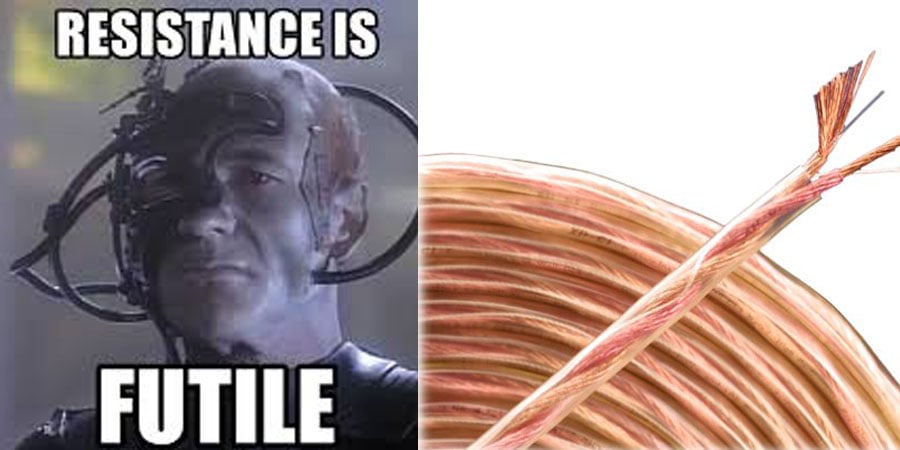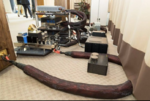Question Speaker cable for PMC twenty5 24s
Page 2 - Seeking answers? Join the What HiFi community: the world's leading independent guide to buying and owning hi-fi and home entertainment products.
You are using an out of date browser. It may not display this or other websites correctly.
You should upgrade or use an alternative browser.
You should upgrade or use an alternative browser.
D
Deleted member 108165
Guest
Whats the point? It's the same wire dressed in a black dinner jacket 🙂Van damme hifi beats the blue studio so go for that if you choose van damme
davidf
Well-known member
Personally, I like what AudioQuest does. The solid core construction lacks the graininess in the higher frequencies that can be apparent in multi-strand cables, and I find the bass is more controlled - less warm, but more controlled. I’ve found similar qualities in other solid core cables in the past too. I also like Naim’s NAC-A5, but its no longer around the £5/m it was back when I liked it...
D
Deleted member 108165
Guest
I can see what you mean David as I've just had a look at their website... but they sure do talk a load of b*llocks in their blurb about the features of the cable:
SOLID LONG-GRAIN COPPER (LGC) CONDUCTORS
Solid Long-Grain Copper (LGC) allows a smoother and clearer sound than cables using regular OFHC (Oxygen-Free High-Conductivity) copper. Solid conductors prevent strand interaction, a major source of distortion. The surface quality is critical because a conductor can be considered as a rail-guide for both the electric fields within a conductor, and for the magnetic fields outside the conductor. LGC has fewer oxides within the conducting material, less impurities, less grain boundaries, and definitively better performance.
CARBON-BASED NOISE- AND CROSSTALK-DISSIPATION SYSTEM
This cable's negative conductors are covered with partially conductive Carbon-Loaded Polyethylene. This remarkable material reduces radio-frequency garbage being fed back into the amplifier. The sonic benefit is exactly the same reduction in "hash" and improved dimensionality that comes whenever RF interference is reduced in an audio circuit. In addition, a carbon layer damps interaction between positive and negative conductors, and an external Carbon-Based Noise-Dissipation System reduces external interference.
FOAMED-POLYETHYLENE INSULATION (FOR ALL POSITIVE CONDUCTORS)
Any solid material adjacent to a conductor is actually part of an imperfect circuit. Wire insulation and circuit board materials all absorb energy. Some of this energy is stored and then released as distortion. Tower, however, uses air-filled Foamed-Polyethylene Insulation on both conductors. Because air absorbs next to no energy and Polyethylene is low-loss and has a benign distortion profile, Foamed-PE, with its high air content, causes much less of the out-of-focus effect common to other materials.
😆
SOLID LONG-GRAIN COPPER (LGC) CONDUCTORS
Solid Long-Grain Copper (LGC) allows a smoother and clearer sound than cables using regular OFHC (Oxygen-Free High-Conductivity) copper. Solid conductors prevent strand interaction, a major source of distortion. The surface quality is critical because a conductor can be considered as a rail-guide for both the electric fields within a conductor, and for the magnetic fields outside the conductor. LGC has fewer oxides within the conducting material, less impurities, less grain boundaries, and definitively better performance.
CARBON-BASED NOISE- AND CROSSTALK-DISSIPATION SYSTEM
This cable's negative conductors are covered with partially conductive Carbon-Loaded Polyethylene. This remarkable material reduces radio-frequency garbage being fed back into the amplifier. The sonic benefit is exactly the same reduction in "hash" and improved dimensionality that comes whenever RF interference is reduced in an audio circuit. In addition, a carbon layer damps interaction between positive and negative conductors, and an external Carbon-Based Noise-Dissipation System reduces external interference.
FOAMED-POLYETHYLENE INSULATION (FOR ALL POSITIVE CONDUCTORS)
Any solid material adjacent to a conductor is actually part of an imperfect circuit. Wire insulation and circuit board materials all absorb energy. Some of this energy is stored and then released as distortion. Tower, however, uses air-filled Foamed-Polyethylene Insulation on both conductors. Because air absorbs next to no energy and Polyethylene is low-loss and has a benign distortion profile, Foamed-PE, with its high air content, causes much less of the out-of-focus effect common to other materials.
😆
davidf
Well-known member
I used to use NAC-A5 back in the 90s with even budget systems, but that was when it was less than a fiver a metre - I see it’s now £30/m!! Used would be your best bet, and seeing as the cable has been around for over 30 years, you should see a wide range of used prices.Thanks Davidf, I will look into AudioQuest and Naim NAC-A5.
The original cable was more like Linn cable at the time, but from early 90s it started using the far less flexible sheathing that’s about as bendy as bamboo. But sounded great though.
davidf
Well-known member
I don’t really get hung up on the technicalities of cables - I just listen to them. Manufacturers can do what they like to them and make them out of whatever they want, im not really too interested. Talking to Bill Lowe is an experience. He’s the sort of guy you could just chat to all day long. Interesting, lots of stories, and knows what he’s talking about. They do get quite technical, but Bill’s a technical guy.I can see what you mean David as I've just had a look at their website... but they sure do talk a load of b*llocks in their blurb about the features of the cable:
abacus
Well-known member
scene
Well-known member
I have no idea why they're attempting to use speaker cables to cook their bratwurst - but there's not accounting for taste...if thickness matters View attachment 870
Al ears
Well-known member
I thought an Anaconda had slipped into the room......They look like massive dried chillies.
scene
Well-known member
You say chilli, I say bratwurst 😉They look like massive dried chillies.
Unless the picture is doctored, they can't be so heavy, judging by how they're sitting in the background of the picture.I wonder what the price is and how heavy it is
As for price: way more than any sane person would pay, I suspect.
Or some kind of sea creature,monster.
Unless you use 1 ohm speakers (apogee Scintilla 1 ohm, 76-78 db) and the biggest hegel,mcintosh,krell,mark levinson 1000 watt or more and 10 meters i don't get it why it has to be so thick
Unless you use 1 ohm speakers (apogee Scintilla 1 ohm, 76-78 db) and the biggest hegel,mcintosh,krell,mark levinson 1000 watt or more and 10 meters i don't get it why it has to be so thick
michael hoy
Well-known member

Van Damme 4mm Hi-Fi Speaker Cable UP-LCOFC - Unterminated | Mark Grant Cables
Van Damme 4mm Directional Hi-Fi Speaker Cable – Per Metre. Van Damme Product code: VDC 268-504-000. This is off the reel cable priced per metre. Order the quantity and length you require.
 www.markgrantcables.co.uk
www.markgrantcables.co.uk
TheJoker
Well-known member
Seeing as PMC advice in there own manuals is that expensive cables are a waste i'd follow there advise. I use linn k20 through out all the systems ive had and to be honest ive found nothing that can better there "sound" when i have been a bit a curious too see if anything can make a difference.
Look at what these companies use at shows, are they using a bell wire to connect to the speaker? if they are using anything over £3pm then something just ain't right, i mean by there own admission if expensive cables don't make any difference why on earth would they spend hundreds/thousands of pounds to demonstrate their speakers on anything but a cheap decent gauge cable? just a thought!
With the bristol show looming it a good time to take a sneaky peek at what different companies use.
Clarkey_71
Well-known member
I've used Chord Company cables for years, both speaker and interconnect. I've always liked their sound.
I also have PMC speakers, and they match perfectly.
I also have PMC speakers, and they match perfectly.
Im back with my Qed XT40 and this cable also sounds good, slightly difference than Blue jeans cable but still very good.
Avoid silver cable since they often make the tweeter sound like a metal dome tweerer in a negative way, there is exceptions where silver cable are perfect for a system.
Avoid silver cable since they often make the tweeter sound like a metal dome tweerer in a negative way, there is exceptions where silver cable are perfect for a system.
Hi,
I use tellurium black mk1 which seem to work well. Open detailed sound ...
Quite agree it might be nice to know if he has a budget for these cables ....but he seems simply wanting to know people's thoughts on them, the way most cable threads go. I notice he hasn't bothered to come back with any feedback
It's good to know that it doesn't matter what the cost is, the cable just needs to be thick and low resistance for best results. Tellurium or Ebay 6mm, the result will be the same.
Last edited:
Why 6mm? Why not 2.5mm?It's good to know that it doesn't matter what the cost is, the cable just needs to be thick and low resistance for best results. Tellurium or Ebay 6mm, the result will be the same.
Either speaker cables make a difference or they don't.
Thickness makes a difference in signal loss and damping factor, if it's noticeable i don't know, i havn't listen for it, but if i have to choose from 2 cables and theres a difference in gauge i wil choose the one with lowest gauge (the thickest cable)

 www.audioholics.com
www.audioholics.com
Choosing the Right Speaker Wire Gauge for Optimal Performance
We discuss speaker wire gauge and how to choose the best audio cables based on your loudspeaker impedance and distance to your amplifier to achieve best performance.
Why 6mm? Why not 2.5mm?
Either speaker cables make a difference or they don't.
2.5 will be higher resistance.
Similar threads
- Replies
- 65
- Views
- 7K
- Replies
- 5
- Views
- 2K

Space.com is part of Future plc, an international media group and leading digital publisher. Visit our corporate site.
© Future Publishing Limited Quay House, The Ambury, Bath BA1 1UA. All rights reserved. England and Wales company registration number 2008885.

